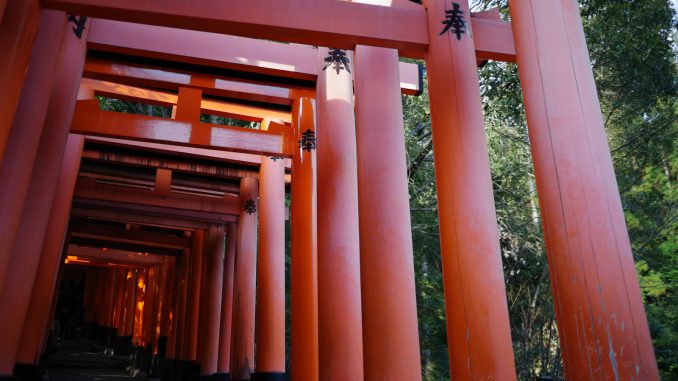
From an ancient age, Japan is a country many religious has come and blended into 和風【WA-FUU(Harmonized Style)】. The same is true in religious. Japanese religions are very roughly divided into three kinds;神道【SHINTOU】,仏教【BUKKYOU】and 儒教【JYUKYOU】and all of them are united with people’s daily life naturally.
▶ESSAY: Why we often call Japanese style “和風【WA-FUU】”=「harmonized style」 instead of ”日本風【NIHON-FUU】“=「Japanese style」? Is Japan a country harmonized even religions?七福神【SHICHI-FUKU-JIN】or “Seven Lucky Gods” is an exhibition of world deities.
▶ESSAY: How different 神【KAMI】of “one god religious” to Japanese 神道【SHINTOH(SHINTOISM)】?
3-(1)▶History of Japanese religious. From national religion 神道【SHINTOU(Shintoism)】to 仏教【BUKKYOU(Buddhism)】and 儒教【JYUKYOU(Confucianism)】, they were imported from continent.
All Japanese are belong to nearest shrine where he or she was born as 氏子【UJIKO】Shrine parishioner, so all Japanese are natural born Shintoist, regardless of they are conscious it or not.
3-(2)▶神道【SHINTOU】All Japanese are natural born Shintoist belong to 神社【JINJYA(SHRINE)】of their region as a 氏子【UJIKO】.
At the same time, much of Japanese are 仏教徒【BUKYYOU-TO(Buddhist)】belonging to a temple as 檀家【DANKA( Supporting Family)】.
3-(3)▶仏教【BUKKYOU】At the same time, much of Japanese are Buddhist. Japanese Buddhism is broadly divided into 6 kinds.
That’s a reason that Japanese total religious population is more than Japanese population.
4. 儒教【JYUKYOU】Confusionism influences Japanese education or corporate culture.
5. Conclusion
<CONTENTS>
3. 仏教【BUKKYOU】At the same time, much of Japanese are Buddhist. Japanese Buddhism is broadly divided into 6 kinds.
▶ESSAY: How to recognize temples and shrines in Japan?
5. Conclusion
In an ancient time called 縄文時代【JYOUMON-JIDAI(Rope pattern pottery era/BC14000-BC3000※lasted about 10000 years)】, Japan was a country of Animism which every things have their own spirits and great things like mountains, rocks, fire, and even humankinds could become 神【KAMI】.
In 6th. century, Buddhism was brought from Eurasia continent ( born at India, via ancient China and Korean peninsula).
A great politician named 聖徳太子【SYOUTOKU-TAISHI】had accepted and improved 仏教(Buddhism) and 儒教(Confucianism) , and said 和【WA(Harmony)】is precious and tried to harmonize those religious. He was killed by somebodies, but his thoughts are remaining in Japanese people’s minds and history, then he become pictures of bills as much as 7times( it is the high record of through history of Japan).
After that, although there have been several conflicts including fierce ones, in Japan, 神道【SHINTOU】, 仏教【BUKKYOU】and other religious are coexisting.
During W.W.2, The 天皇【TENNOU(Emperor)】, the center of 神道(Shintoism), believed as the 神【KAMI(God)】 and used as a symbol of militarism. After the war, he became just a symbol of Japan country. Any religious are separated from politics and people’s freedom of religions is guaranteed.
There are a lot of shrines and temples from very small to huge ones, every where in Japan, even small town or villages.
Nowadays, there are so many 神社【JINJYA( Shrines )】in all towns and people visit there in happy occasions like baby birth, celebrate children’s grow in their 7-5-3 years old, weddings. A lot of 祭【MATSURI(Festivals)】are hold especially in summer .
There are also many お寺【(O)-TERA(Temples)】and people use them as funerals, passed person’s memorial ceremonies after their death’s 7th day, 49th day, 1st year, 3rd year, 7th year. People go to their ancestor’s graves in お盆【O-BON】and お彼岸【(O)-HIGAN】, and some temples have festivals called 縁日【EN-NICHI】.
儒教【JYUKYOU(Confucianism)】is rather philosophy than religion, and it’s taught are still living in Japanese way of school education, and company mottos which was spread to the world in high economic period with overseas expansion of Japanese companies in around 1990’s.(And sometimes 道教【DOU-KYOU(Taoism)】influences particular peoples like who admire a life style, for example, fishing all day long in nature).
There are also new religions, churches for Christians and Mosques for Muslims living in Japan, too.
Conclusion;
However, not less Japanese peoples say they are non-religious when they asked “What is your religion?”. There are so many shrines and temples in each towns, but they only visit them in special occasions like festivals, events or sightseeing. It is not like Christian people go to church every Sunday. Usually, there is not a custom like baptism(except some new religious). It would be surprise for foreigners who have strong faiths, but it can not be said that Japanese are not religious people.
Many faiths (which are Shinto, Buddhism and sometimes Confucianism) are blending into their daily lives , way of thinking and spirituality of the Japanese people, and even their lives themselves can be religious.
Many faiths are blending into their daily lives and spirituality of the Japanese people, and even their lives themselves can be religious.
That’s one of a reason it is said that Japanese peoples have high public morals ; late of crimes is low and women can walk alone in the night, and news which people help each other at the times of natural disasters like earthquakes without rioting and looting surprise the world.

Leave a Reply